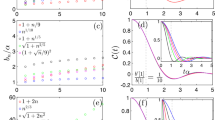Abstract
By a joint use of theory and analog simulation the low-friction regime of the Duffing oscillator is explored. In the weak-temperature case it is shown that the low-friction regime, in turn, must be divided in two well-distinct subregimes. In the former one, characterized by the frictionγ ranging from 2Ω 0 (Ω 0 is the harmonic frequency) up to a lower bound γT, the method of statistical linearization applies and a continued fraction procedure (CFP) generated by the Zwanzig-Mori projection techniques is shown to provide correct information for both the renormalized frequency of the oscillator and the corresponding line shape. The latter subregime, characterized by the frictionγ ranging fromγ = 0 toγ = γ T , is fraught with the complete breakdown of the statistical linearization method. The CFP is shown to provide an incorrect picture of the line shape while suggesting a novel mean field approximation which is then proven analytically via an alternative method of calculation. This method consists of expressing the system in a form reminiscent of the model of Kubo's stochastic oscillator. By using this alternative approach we are in a position to account for the residual linewidth which is shown by the analog experiment to survive forγ → 0.
Similar content being viewed by others
References
J. B. Morton and S. Corrsin,J. Math. Phys. 10:361 (1969); J. B. Morton and S. Corrsin,J. Stat. Phys. 2:153 (1970).
A. R. Bulsara, K. Lindenberg, K. E. Shuler, R. Frehlich, and W. A. Coles,J. Non-Linear Mech. 17:237 (1982).
M. Bixon and R. Zwanzing,J. Stat. Phy. 3:245 (1971).
K. S. J. Nordholm and R. Zwanzing,J. Stat. Phys. 11:143 (1974).
A. B. Budgor,J. Stat. Phys. 15:355 (1976).
A. B. Budgor, K. Lindenberg, and K. E. Shuler,J. Stat. Phys. 15:375 (1976).
A. B. Budgor and B. J. West,Phys. Rev. A 17:370 (1978).
K. Matsuo,J. Stat. Phys. 18:535 (1978).
A. D. Bulsara, K. Linderberg, and K. E. Shuler,J. Stat. Phys. 27:787 (1982).
M. C. Valsakumar, K. P. N. Murthy, and G. Ananthakrishna,J. Stat. Phys. 30:617 (1983).
B. J. West, G. Rovner, and K. Linderberg,J. Stat. Phys. 30:633 (1983).
P. Grigolini,J. Stat. Phys. 27:283 (1982).
P. Grigolini,Nuovo Cimento 63B:17 (1981).
P. Grigolini, inMemory Function Approaches to Stochastic Problems in Condensed Matter, M. W. Evans, P. Grigolini, and G. Pastori Parravicini eds. (I. Prigogine and S. A. Rice, general eds.)Adv. Chem. Phys. 62:1 (1985); G. Grosso and G. Pastori Parravicini,ibid.
H. Mori,Prog. Theor. Phys. 33:423 (1965);34:399 (1965).
R. Kubo,Adv. Chem. Phys. 15:101 (1963).
M. Ferrario, P. Grigolini, A. Tani, R. Vallauri, and B. Zambon, inMemory Function Approaches to Stochastic Problems in Condensed Matter, eds. M. W. Evans, P. Grigolini, and G. Pastori Parravicini, eds. (I. Prigogine and S. A. Rice, general eds.)Adv. Chem. Phys. 62:225 (1985).
R. I. Cukier, K. E. Shuler, and J. D. Weeks,J. Stat. Phys. 5:99 (1972); M. Maekawa and K. Wada,Phys. Lett. 80A:293 (1980).
S. Grossmann and B. Sonneborn-Schmick,Phys. Rev. A 25:2371 (1982).
R. Zwanzig,Phys. Rev. 124:983 (1961).
H. S. Wall,Analytical Theory of Continued Fractions (Van Nostrand, New York, 1948).
L. Fronzoni, P. Grigolini, B. Mannella, and B. Zambon,Phys. Lett. 107A:204 (1985).
S. Novak and R. G. Frehlich,Phys. Rev. 26A:3660 (1982)
M. H. Jensen, P. Bak and T. Bohr,Phys. Rev. 30A:1960 (1984)
T. Bohr, P. Bak, and M. H. Jensen,Phys. Rev. 30A:1970 (1984)
B. A. Huberman and J. P. Crutchfield,Phys. Rev. Lett. 43:1743 (1979)
D. D'Humieres, M. R. Beasley, B. A. Huberman, and A. Libchaber,Phys. Rev. 26A:3483 (1982).
L. Landau and E. Lifshitz,Mecanique (Mir, Moscow, 1976).
R. L. Stratonovich,Topics in the Theory of Random Noise, Vol. 1 (Gordon and Breach, New York, 1967), p. 115.
V. Seshandri, B. J. West, and K. Linderberg,Physica 107A:219 (1981).
S. Faetti, C. Festa, L. Fronzoni, P. Grigolini, and P. Martano,Phys. Rev. 30A:3252 (1984).
L. Fronzoni (in preparation).
H. Risken,The Fokker-Planck Equation (Springer, New York, 1984), p. 358.
M. Giordano, P. Grigolini, P. Marin, and D. Leporini, inMemory Function Approach to Stochastic Problem in Condensed Mather, M. W. Evans, P. Grigolini, and G. Pastori, eds. (I. Prigogine and S. A. Rice, general eds.)Adv. Chem. Phys. 62:321 (1985).
T. Fonseca and P. Grigolini, unpublished.
Author information
Authors and Affiliations
Rights and permissions
About this article
Cite this article
Fronzoni, L., Grigolini, P., Mannella, R. et al. The Duffing oscillator in the low-friction limit: Theory and analog simulation. J Stat Phys 41, 553–579 (1985). https://doi.org/10.1007/BF01009022
Received:
Revised:
Issue Date:
DOI: https://doi.org/10.1007/BF01009022




